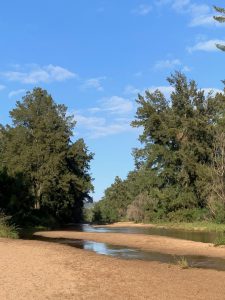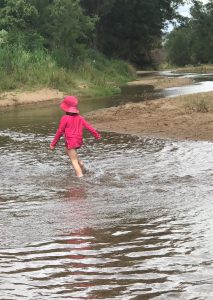We introduced you to Linda’s family day care (FDC) and some ideas on risky play with an Amplify article featuring her ‘River Kindy’. If you missed it, catch up here, and if you’re one of the people who then asked to find out more about risky and natural play, you’re in for a treat today.
Linda’s ready access to a beautiful river is just one part of her natural play philosophy. When children enrol in Linda’s service the families know they are in for a full experience of the outdoors, without a mini-high-vis vest in sight. She has written a two-part article that walks us through the process that led to River Kindy being a regular experience for children at her service. In part one today, she says it all begins with trust.
It won’t happen overnight
River Kindy and risky play wasn’t something that just happened overnight. There was lots of work going on behind the scenes of my service, and within me.
I had to work out how I felt about risky play.
I needed to reimagine my philosophy.
I needed to understand my thoughts on early childhood
I had to learn to trust my choices and myself.
I had to learn what it takes for a child to trust me in a risky environment.
I had to build my skills, including developing secure attachment.
That process means I really feel strongly these days about ‘adutlifying’ a child’s play. Once some adult steps in, the play is never the same.
A question of trust
First I had to learn to trust myself and the choices I was making for my service and the children.
 Image credit: Sunshine and Puddles FDC
Image credit: Sunshine and Puddles FDC
I believed that the children deserved more and I had to trust in my instincts about that. Setting small, achievable goals that stretched my beliefs was the starting point.
First up, I asked can I trust myself not to interrupt in the children’s play? I tried to look at myself and my teaching through different lenses and – fortunately – I started to like what I saw. I do trust the children to know themselves. I can support them to achieve that knowledge.
I had to learn to step away from their play – safe in the knowledge that I was visible but unobtrusive. That process means I really feel strongly these days about ‘adutlifying’ a child’s play. Once some adult steps in, the play is never the same. Do we have the right to do that if the children are content and/or safe? I think not.
It’s only a few sentences when I write it, but it took a while for me to re-learn the trust in myself and my choices. The fact that I wanted to change made it so much easier.
Philosophy revised
My philosophy is ever changing and developing.
At first it was just about children meeting the Early Years Learning Framework (EYLF) outcomes. These days I wouldn’t even call that approach a philosophy as it was just about the curriculum and not the child!
These days I feel the curriculum should fit the child not the other way around. Now it’s about autonomy, freedom and community. As I write this article, I am also considering social justice as something that needs to be added to my philosophy. All good things take time, right?
Looking back, it was exhausting for me to have to keep stopping the children from doing what was instinctive for them, but I was a good educator and I did what was required of me.
Secure attachment
For the first two-thirds of my FDC career I was in a traditional setting where children were kept safe and away from risk.
Looking back, it was exhausting for me to have to keep stopping the children from doing what was instinctive for them, but I was a good educator and I did what was required of me. I kept them safe and I could see the consequences of this safety building up in them, and in me.
The children would grasp every opportunity they could to engage in risky behaviours. I know now that it was natural for them to want to take chances but at the time I saw it as challenging behaviour in most of the children. Yet, in fact, most were not children with high needs at all. Instead, there was something missing in their environment.
I had to look long and honestly at how my environment was contributing to the ‘challenge’ and I found it sadly lacking. There is only so much you can do in a traditional, contained environment. I made the decision to look at other options. I wanted to see if I could find something that suited my beliefs and what I felt the children deserved.
That’s when I found nature based early childhood education, and once I made the decision to change from traditional FDC I had to change me as well.
Risky play
I needed to make the shift from thinking what to do with the children to thinking what more I could offer them. I admit it was a bit scary.
 Image credit: Sunshine and Puddles FDC
Image credit: Sunshine and Puddles FDC
All my previous teaching was based on low- to no-risk programs. Now I was having to think what risks I was comfortable offering. With a deliberate attitude, though, it turned out I was very comfortable with just about everything the children were willing to try.
When I found activities or settings that made me uncomfortable, I had to work out why and if there was a way I could move to a comfort level with the risk. Generally, I found my fears were based on lack of knowledge. For example, I really wasn’t comfortable with the children using knives. Once I did some research in readings and with peers I realised that I could work with the children and knives and other tools, too.
So, the children and I learn skills together. Seeing their faces when they master any new skill is amazing but seeing them master a risky skill fills my heart with joy. This stage – learning together – is when I really started to trust in myself. I knew with research and peer support I was capable of anything, as were the children.
Next week, Linda looks at how her understanding of early childhood changed as she learned more about risky play and trusting her own instincts. She explores the concept of Environmental Satisfaction for indoor environments as well as outside, and describes her process for getting families on board with a nature based approach – leading to the birth of River Kindy
END PART ONE
Related reading
Meet the author

Hi! I'm Linda Tandy and I live in Bega NSW. I have been working in Family Day Care for around 15 years and the last five years in Nature Based Family Day Care. This is where I found my love. My primary interest is children being given the opportunity to have a joyous and adventurous childhood where they are free to direct and guide their own path. To see themselves as capable and valuable individuals that hopefully become vibrant and confident adults. Nature Based Family Day Care makes sense to me. Traditional Family Day Care is a great model for Early Childhood but Nature Based Care makes it even better. Six or so years ago I found myself very disillusioned in my role and felt it was either time for me to move on or find a different way to run my Family Day Care Service. I wasn’t happy with the lack of authentic opportunities given to the children or the fact they could not drive their own learning in a way that was natural for them. After all weren’t we given the opportunity as children to run free and find our own fun? I believed even then that children are naturally drawn to risk and adventure. I’m so pleased I found this current model that gives children back their childhood.